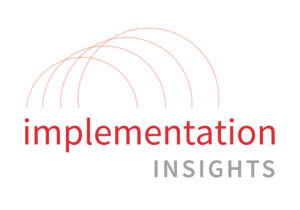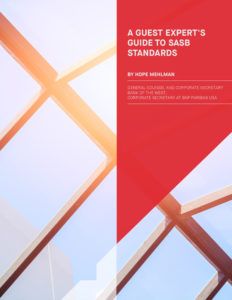ING (NYSE: ING), the global bank headquartered in Amsterdam, was one of the first European companies to disclose using the SASB Standard for commercial banks. We connected with Sandra Schoonhoven, Head of Sustainability Programmes, to discuss ING’s approach to climate risk reporting on the heels of the bank’s first integrated climate report.
ING Group is a pioneer among banks in reporting on climate risk. With intense and growing interest on this topic, what feedback have you been getting from investors about your climate risk reporting?
Thanks for recognising our efforts – ING has been a pioneer in climate action since we announced our Terra approach in 2018. We co-created the industry-leading PACTA for Banks approach with think tank 2° Investing Initiative. In the area of reporting, we produced the industry’s first climate alignment report in 2019. Concurrently, we’ve made strides in addressing financial risk through the lens of the TCFD recommendations. Here again ING took a collaborative approach by participating in a UNEP FI-coordinated implementation pilot. While we’re already known as a climate action leader, we continue to seek opportunities to improve our climate disclosures. We’re working on improving the synergies between our climate-related financial risk and alignment workstreams. As we make progress in implementing the TCFD recommendations, we implement learnings continuously across all recommended disclosures, even those we tackled in disclosure year one. And we look forward to exploring how our climate reporting can benefit from the Prototype Climate-related Financial Disclosure Standard developed by the so-called Group of Five.
We’ve received a high level of interest in and support for our climate reporting from some of our large institutional investors and the investment community in general. Our IR team has seen a marked increase in investor interest in our climate approach since 2018. Many of these investors have asked us to continue to share our learnings with the broader banking industry. We’ve also seen our climate disclosures featured in best-practice reports prepared by sell-side analysts as well as think tanks. It is very encouraging to see this level of interest and support for our climate work.
How do the SASB Standards help in setting ESG strategy, particularly around metrics and targets?
ING was one of the first European companies to implement the SASB Commercial Banks Standard. And we did this at our first opportunity – in our 2018 Annual Report – following the November 2018 release of the codified Standards. It is great to see the fast and large-scale uptake of the Standards and their use by investors globally. The Standards along with the geographically diverse SASB Standards Investor Advisory Group (IAG) have helped SASB [now under the Value Reporting Foundation] become a truly global standard setter.
SASB Standards, guidance and thought leadership pieces have found multiple applications in our work as a bank. We benefitted from SASB and CDSB’s TCFD Implementation Guide in scoping our climate risk disclosure. Furthermore, SASB’s financial risk focus has helped us map our credit exposure to those industry sectors that are most exposed to physical risks of climate change.
Have you seen rising interest from mainstream investors in sustainability issues? How does the sustainability team get involved in investor relations activities?
The sustainability team has become increasingly involved in interactions with shareholders and investors. Members of the sustainability team frequently participate in calls and meetings led by our IR and front-office colleagues. We provide investors with information and context on our sustainability strategy, and also draw learnings from the questions we get. We aim to continuously improve our disclosures in line with investor expectations.
We’ve seen growing interest in our climate strategy and sustainability direction not only from equity investors but also increasingly from fixed-income investors. We believe that interest from both groups is underpinned to some extent by the overall market growth for ESG-related investment products. For example, there are reports that estimate ESG funds more than doubled in 2020 from the prior year. For ING, this is an opportune moment to showcase our pioneering climate action work covering both our retail and wholesale banking portfolios. For example, ING won the Green Bond Pioneer Award 2019 by Climate Bonds Initiative for the largest ever green bond transaction from a European bank. These large volumes support our climate ambitions such as our energy net-positive goal for the mortgage book.
How do you view the balance between managing material ESG impacts on ING Group’s shareholder value versus external impacts on society and the environment? In other words, do you have to balance ‘value’ and ‘values’?
As a well-established global systemically important bank, we have a long-term focus. We’re encouraged to see the concept of double materiality enshrined in EU disclosure rules, which is confirmation that our approach so far is the right one. The global shift away from shareholder primacy and toward stakeholder inclusivity means that companies need to address the impacts and values for all key stakeholders.
Our environmental and social risk (ESR) policy framework, which applies in financing corporate clients, is an example of how we capture both types of material impacts. The framework contains a number of finance exclusions linked to either financial risk (e.g. thermal coal) or broader impacts on society (e.g. animal welfare and animal testing). Every client and transaction is assessed, monitored and evaluated against the requirements of our ESR framework to ensure compliance and limit negative impact on the environment and communities. This way, environmental and social impact are taken into account every time we make financing or investment decisions. We also say no to certain companies and sectors. We screen every transaction and also respond to financing requests with “yes, but…,” outlining sustainability improvements the client must make first.
How does ING Group – and the wider community of corporate reporters – benefit from participation in the SASB Standards Advisory Group (SAG)?
We’ve benefited from the opportunity to participate in SASB consultations and special research projects and inform our feedback to industry bodies and standard-setting organisations. SAG members also benefit from engagement opportunities at SAG meetings with like-minded professionals and industry leaders. The geographic diversity of the SAG and SASB’s efforts to align with the IAG help inform members’ disclosure strategy. The SAG plays a key role in informing standard-setting and improvement projects at SASB to the benefit of both preparers and users.
As the corporate world strives towards a global system of ESG reporting, how do you see Europe’s role?
Europe has been one of the world’s most ambitious regions when it comes to sustainability. The EU has set ambitious plans to encourage financial markets to contribute to a set of six environmental objectives. The past year saw the launch of a pioneering taxonomy addressing Europe’s two climate objectives and we expect taxonomies on the remaining four objectives in the coming years. Meanwhile, disclosure rules, such as the NFRD – now CSRD – and the new SFDR, have been introduced to encourage the region’s companies and investors to disclose ESG data in line with the objectives. The CSRD’s double materiality focus is an example of the region’s level of ambition going beyond financial risk management.
SIDEBAR: Aligning ING’s lending portfolio with ESG
We’re taking a sector-based approach to ESG integration. Our environmental and social risk policy restricts a number of sub-sectors and activities with excessive negative E&S impacts, while in other sectors it mandates acceptance thresholds or enhanced due diligence. In the area of climate alignment, our sector-based approach means that each sector has its own methodology, scope, portfolio target and metrics. That’s because each sector’s transition pathway focuses on what the companies in that sector are producing. For example, in power generation, we look at what type of ‘technology’ is producing the power (e.g. wind turbines or gas-fired power stations). In the area of climate risk, we have started setting climate-related metrics and targets for priority sectors. These will help us adjust our risk appetite and policies. Our 2020 Climate Risk Report provided an update on the sectors and geographies where we’d made progress in assessing climate-related financial risk. In our recently released 2021 Climate Report, we provide a progress update on both our climate risk activities and our climate alignment ambitions. Also, we present our integrated climate approach for the first time, also linking to biodiversity, circular economy and human rights.
In the area of human rights as well, we’re engaging clients in sectors where our salient human rights issues are prevalent. We identified the issues and sectors in a UN Guiding Principles-aligned process. Our annual human rights update reports provide a summary of our progress year over year.

